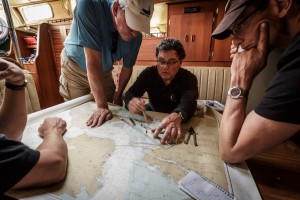Out of all athletes, sailors probably rely the most on their environment. Without the wind, a sailor is nothing, just like a hockey player is nothing without an ice rink. But unlike hockey, sailing is not something that can be done under artificial conditions—inside an arena or a sports complex. Sailing makes you rely almost entirely on external forces: wind, waves, and weather. Good sailors must learn to read those forces to succeed—and good leaders must do the same.
There are a couple of great examples that illustrate how leaders can learn from sailing. First of all: whenever you set out for a sail, it’s always important to plan ahead.
- Check the weather – are any storms forecasted?

- Are all the boat systems and electronics working properly?
- Is anything broken or leaking?
- Do you have all the necessary safety equipment and are there enough lifejackets?
- Did you bring enough food and drinking water for the duration of the trip?
If you’re the skipper of a sailboat, these are just a few of the things on your checklist. Failures or near-failures in planning can teach sailors valuable lessons about preparation, and show them how to become better leaders in the process.
Once you’re out on the water, a whole set of different challenges arise. A good sailor needs to be able to read the wind, in order to fill his sails and sustain momentum. At the same time, he should know when the wind is too strong and becoming dangerous. If he doesn’t reef his sails (reducing their size), his boat will heel and possibly capsize. Like sailors, leaders need to learn their limits: when they have too much momentum; when they’re out of control; when they’re trying to catch too much. Sailing teaches you to recognize your limits and work within them.

Finally, sailing forces you to respond to crisis situations. If something breaks while sailing, you need to be able to fix it before you’re at risk. Jury-rigging is a valuable skill for sailors, just like fast problem-solving is important for leaders. So sailing can teach leaders to deal with problems quickly and decisively. No sailor spends time worrying whether his mast might break! They just deal with it when it happens.
Overall, sailing can help leaders learn to adapt and react to their environments—no matter how challenging. It can also help leaders build confidence, by responding to different crises and cementing trust in their own planning and problem-solving abilities. Finally, sailing is great for teaching you where the edge is—and how to push it.
Happy sailing, leaders!